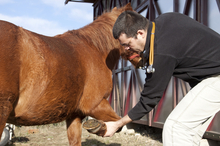According to Ashlee Watts, assistant professor at the Texas A and M College of Veterinary Medicine and Biomedical Sciences, equine lameness is the most costly health problem in the equine industry in regards to the price of medical treatment and for time lost to rest.

Veterinarian diagnosing lameness in horse
Equine lameness is the most costly health problem in the equine industry in regards to the price of medical treatment and for time lost to rest.
According to Watts, "Lameness is limping in the horse. "Sometimes the limping can be so subtle that it is difficult or impossible to see and sometimes it is very obvious. Lameness usually happens because of a problem with the musculoskeletal system in a limb, such as arthritis in a joint; however, it can also occur because of neck or back pain."
Orthopedic injuries, or injuries that directly affect the musculoskeletal system, are the most common cause of equine lameness and include any damage to the hoof, bones, joints or soft tissue.
Lameness in horses has multiple causes, some obvious and some that are difficult to diagnose. Following are the most common causes of equine lameness:
- Traumatic injuries: Sprains, strains, fractures and other injuries to the musculoskeletal system including bones muscles, cartilage, tendons, ligaments and joints; damage to the nervous system including the brain, spinal cord, and nerves
- Degenerative diseases: Arthritis, degenerative joint disease, osteoarthritis
- Foot related injuries, infections and diseases
- Diet related diseases: Laminitis (founder), azoturia (tying up), developmental orthopedic diseases (DOD)
- Limb deformities: Angular limb deformities and flexural limb deformities
Common signs of more severe lameness include head bobbing while walking or trotting. Head bobbing is usually a telltale sign of front limb lameness, while hind limb lameness is usually identified by a hip hike or drop.
Although equine lameness is a common health issue in horses, there are ways horse owners can prevent the costly condition. Proper and timely foot care that commonly includes shoeing is one of the most important methods of preventive care; however, it is equally important to choose a reliable and trusted farrier.
"Good routine care, such as regular exercise and regular farrier care, is imperative," Watts said. "Working your horse on proper footing and avoiding heavy mud or overly hard ground will also help prevent lameness. Keeping the horse appropriately fit for the level of exercise that is being performed is also important in preventive care."
Equine lameness potentially affects all horse owners and is the most expensive health problem in the equine industry; however, the condition can sometimes be prevented through proper care and providing safe footing in stalls and working or exercise areas. Watts urges horse owners to contact their veterinarian if they notice any sign of lameness, as this condition should never be neglected.
